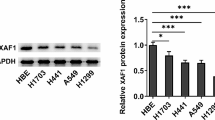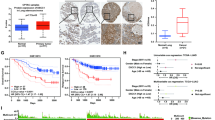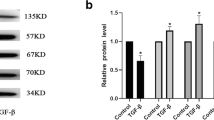Abstract
Heat shock protein B8 (HSPB8) impacts on tumor proliferation and migration of malignancy. However, the role of HSPB8 in lung adenocarcinoma (LUAC) remains unclear. The aim of this study, therefore, was to clarify whether HSPB8 could bring benefits to proliferation and migration of LUAC and its underlying mechanisms. The expression of HSPB8 was first evaluated by immunohistochemistry in 35 LUAC samples. Then, A549 lung adenocarcinoma cells were transfected with pcDNA-HSPB8 or si-HSPB8 to induce HSPB8 overexpression and silence. Cellular activity was evaluated with a Cell Counting Kit-8 (CCK-8) assay. Cell proliferation and migration were observed by EdU assay and scratch assay. Mitochondria-specific reactive oxygen species (mtROS) and membrane potential were measured using MitoSOX Red probe and JC-1 staining. Superoxide dismutase (SOD) activities and malondialdehyde (MDA) level were measured using commercial kits, respectively. HSPB8 protein, mitochondrial fusion protein MFN2 and mitochondrial fission protein p-Drp1/Drp1 were measured using western blot. Compared with the normal tissues, the expression of HSPB8 protein was higher in LUAC tissues and upregulation of HSPB8 protein was related to tumor size and tumor location. Furthermore, HSPB8 overexpression aggravated cell proliferation and migration of A549 cells. Mechanistically, HSPB8 suppressed mitochondrial impairment, leading to promoting the progress of A549 lung adenocarcinoma cells. These data demonstrate that HSPB8 plays an important role in progression of LUAC and may be a new target to treat LUAC.






Similar content being viewed by others
References
Bray F, Ferlay J, Soerjomataram I, Siegel RL, Torre LA, Jemal A (2018) Global cancer statistics 2018: GLOBOCAN estimates of incidence and mortality worldwide for 36 cancers in 185 countries. CA Cancer J Clin 68:394–424
Ge C, Li R, Song H, Geng T, Yang J, Tan Q, Song L, Wang Y, Xue Y, Li Z, Dong S, Zhang Z, Zhang N, Guo J, Hua L, Chen S, Song X (2017) Phase I clinical trial of a novel autologous modified-DC vaccine in patients with resected NSCLC. Bmc Cancer 17:884
Peng Z, Wang J, Shan B, Yuan F, Li B, Dong Y, Peng W, Shi W, Cheng Y, Gao Y, Zhang C, Duan C (2017) Genome-wide analyses of long noncoding RNA expression profiles in lung adenocarcinoma. Sci Rep 7:15331
Hong QY, Wu GM, Qian GS, Hu CP, Zhou JY, Chen LA, Li WM, Li SY, Wang K, Wang Q, Zhang XJ, Li J, Gong X, Bai CX (2015) Prevention and management of lung cancer in China. Cancer-Am Cancer Soc 121(Suppl 17):3080–3088
Wu S, Zhou F, Zhang Z, Xing D (2011) Mitochondrial oxidative stress causes mitochondrial fragmentation via differential modulation of mitochondrial fission-fusion proteins. Febs J 278:941–954
Weinberg SE, Chandel NS (2015) Targeting mitochondria metabolism for cancer therapy. Nat Chem Biol 11:9–15
Chen SS, Tu XY, Xie LX, Xiong LP, Song J, Ye XQ (2018) Peptide nucleic acids targeting mitochondria enhances sensitivity of lung cancer cells to chemotherapy. Am J Transl Res 10:2940–2948
Lou Y, Li R, Liu J, Zhang Y, Zhang X, Jin B, Liu Y, Wang Z, Zhong H, Wen S, Han B (2015) Mitofusin-2 over-expresses and leads to dysregulation of cell cycle and cell invasion in lung adenocarcinoma. Med Oncol 32:132
Xie Y, Lv Y, Zhang Y, Liang Z, Han L, Xie Y (2019) LATS2 promotes apoptosis in non-small cell lung cancer A549 cells via triggering Mff-dependent mitochondrial fission and activating the JNK signaling pathway. Biomed Pharmacother 109:679–689
Kudryavtseva AV, Krasnov GS, Dmitriev AA, Alekseev BY, Kardymon OL, Sadritdinova AF, Fedorova MS, Pokrovsky AV, Melnikova NV, Kaprin AD, Moskalev AA, Snezhkina AV (2016) Mitochondrial dysfunction and oxidative stress in aging and cancer. Oncotarget 7:44879–44905
Wu HY, Yang FL, Li LH, Rao YK, Ju TC, Wong WT, Hsieh CY, Pivkin MV, Hua KF, Wu SH (2018) Ergosterol peroxide from marine fungus Phoma sp. induces ROS-dependent apoptosis and autophagy in human lung adenocarcinoma cells. Sci Rep 8:17956
Hseu YC, Huang YC, Thiyagarajan V, Mathew DC, Lin KY, Chen SC, Liu JY, Hsu LS, Li ML, Yang HL (2019) Anticancer activities of chalcone flavokawain B from Alpinia pricei Hayata in human lung adenocarcinoma (A549) cells via induction of reactive oxygen species-mediated apoptotic and autophagic cell death. J Cell Physiol 234:17514–17526
Jo HS, Kim DW, Shin MJ, Cho SB, Park JH, Lee CH, Yeo EJ, Choi YJ, Yeo HJ, Sohn EJ, Son O, Cho SW, Kim DS, Yu YH, Lee KW, Park J, Eum WS, Choi SY (2017) Tat-HSP22 inhibits oxidative stress-induced hippocampal neuronal cell death by regulation of the mitochondrial pathway. Mol Brain 10:1
Hu Z, Zeng Q, Zhang B, Liu H, Wang W (2014) Promotion of p53 expression and reactive oxidative stress production is involved in zerumbone-induced cisplatin sensitization of non-small cell lung cancer cells. Biochimie 107 Pt B:257–262
Park SH, Kim JH, Chi GY, Kim GY, Chang YC, Moon SK, Nam SW, Kim WJ, Yoo YH, Choi YH (2012) Induction of apoptosis and autophagy by sodium selenite in A549 human lung carcinoma cells through generation of reactive oxygen species. Toxicol Lett 212:252–261
Smith CC, Yu YX, Kulka M, Aurelian L (2000) A novel human gene similar to the protein kinase (PK) coding domain of the large subunit of herpes simplex virus type 2 ribonucleotide reductase (ICP10) codes for a serine-threonine PK and is expressed in melanoma cells. J Biol Chem 275:25690–25699
Bouhy D, Juneja M, Katona I, Holmgren A, Asselbergh B, De Winter V, Hochepied T, Goossens S, Haigh JJ, Libert C, Ceuterick-de GC, Irobi J, Weis J, Timmerman V (2018) A knock-in/knock-out mouse model of HSPB8-associated distal hereditary motor neuropathy and myopathy reveals toxic gain-of-function of mutant Hspb8. Acta Neuropathol 135:131–148
Yu L, Liang Q, Zhang W, Liao M, Wen M, Zhan B, Bao H, Cheng X (2019) HSP22 suppresses diabetes-induced endothelial injury by inhibiting mitochondrial reactive oxygen species formation. Redox Biol 21:101095
Piccolella M, Crippa V, Cristofani R, Rusmini P, Galbiati M, Cicardi ME, Meroni M, Ferri N, Morelli FF, Carra S, Messi E, Poletti A (2017) The small heat shock protein B8 (HSPB8) modulates proliferation and migration of breast cancer cells. Oncotarget 8:10400–10415
Yao J, Chen Y, Nguyen DT, Thompson ZJ, Eroshkin AM, Nerlakanti N, Patel AK, Agarwal N, Teer JK, Dhillon J, Coppola D, Zhang J, Perera R, Kim Y, Mahajan K (2019) The Homeobox gene, HOXB13, regulates a mitotic protein-kinase interaction network in metastatic prostate cancers. Sci Rep 9:9715
Shen J, Li M, Min L (2018) HSPB8 promotes cancer cell growth by activating the ERKCREB pathway and is indicative of a poor prognosis in gastric cancer patients. Oncol Rep 39:2978–2986
Suzuki M, Matsushima-Nishiwaki R, Kuroyanagi G, Suzuki N, Takamatsu R, Furui T, Yoshimi N, Kozawa O, Morishige K (2015) Regulation by heat shock protein 22 (HSPB8) of transforming growth factor-alpha-induced ovary cancer cell migration. Arch Biochem Biophys 571:40–49
Li XS, Xu Q, Fu XY, Luo WS (2014) Heat shock protein 22 overexpression is associated with the progression and prognosis in gastric cancer. J Cancer Res Clin Oncol 140:1305–1313
Matsushima-Nishiwaki R, Toyoda H, Takamatsu R, Yasuda E, Okuda S, Maeda A, Kaneoka Y, Yoshimi N, Kumada T, Kozawa O (2017) Heat shock protein 22 (HSPB8) reduces the migration of hepatocellular carcinoma cells through the suppression of the phosphoinositide 3-kinase (PI3K)/AKT pathway. Biochim Biophys Acta Mol Basis Dis 1863:1629–1639
Cui XY, Wang N, Yang BX, Gao WF, Lin YM, Yao XR, Ma XT (2012) HSPB8 is methylated in hematopoietic malignancies and overexpression of HSPB8 exhibits antileukemia effect. Exp Hematol 40:14–21
Smith CC, Li B, Liu J, Lee KS, Aurelian L (2011) The Levels of H11/HspB8 DNA methylation in human melanoma tissues and xenografts are a critical molecular marker for 5-Aza-2'-deoxycytidine therapy. Cancer Invest 29:383–395
Gober MD, Smith CC, Ueda K, Toretsky JA, Aurelian L (2003) Forced expression of the H11 heat shock protein can be regulated by DNA methylation and trigger apoptosis in human cells. J Biol Chem 278:37600–37609
Yang S, Tian J, Zhang F, Liu A, Xie B, Chen Q (2019) The protective effects of heat shock protein 22 in lung ischemia-reperfusion injury mice. Biochem Biophys Res Commun 512:698–704
Dadhania V, Zhang M, Zhang L, Bondaruk J, Majewski T, Siefker-Radtke A, Guo CC, Dinney C, Cogdell DE, Zhang S, Lee S, Lee JG, Weinstein JN, Baggerly K, McConkey D, Czerniak B (2016) Meta-analysis of the luminal and basal subtypes of bladder cancer and the identification of signature immunohistochemical markers for clinical use. Ebiomedicine 12:105–117
Hu DD, Li PC, He YF, Jia W, Hu B (2018) Overexpression of coiled-coil domain-containing protein 34 (CCDC34) and its correlation with angiogenesis in esophageal squamous cell carcinoma. Med Sci Monit 24:698–705
Lu W, Zhang H, Niu Y, Wu Y, Sun W, Li H, Kong J, Ding K, Shen HM, Wu H, Xia D, Wu Y (2017) Long non-coding RNA linc00673 regulated non-small cell lung cancer proliferation, migration, invasion and epithelial mesenchymal transition by sponging miR-150-5p. Mol Cancer 16:118
Datta S, Choudhury D, Das A, Mukherjee DD, Dasgupta M, Bandopadhyay S, Chakrabarti G (2019) Correction to: autophagy inhibition with chloroquine reverts paclitaxel resistance and attenuates metastatic potential in human nonsmall lung adenocarcinoma A549 cells via ROS mediated modulation of beta-catenin pathway. Apoptosis 24:434
Strohecker AM, Guo JY, Karsli-Uzunbas G, Price SM, Chen GJ, Mathew R, McMahon M, White E (2013) Autophagy sustains mitochondrial glutamine metabolism and growth of BrafV600E-driven lung tumors. Cancer Discov 3:1272–1285
Maryam A, Mehmood T, Yan Q, Li Y, Khan M, Ma T (2018) Proscillaridin a promotes oxidative stress and ER stress, inhibits STAT3 activation, and induces apoptosis in a549 lung adenocarcinoma cells. Oxid Med Cell Longev 2018:3853409
Tripathi SK, Pandey K, Panda M, Spinella MJ, Rengasamy KR, Biswal BK (2019) The potential of retinoids for combination therapy of lung cancer: updates and future directions. Pharmacol Res 147:104331
Knutson TP, Lange CA (2014) Tracking progesterone receptor-mediated actions in breast cancer. Pharmacol Ther 142:114–125
Li F, Xiao H, Hu Z, Zhou F, Yang B (2018) Exploring the multifaceted roles of heat shock protein B8 (HSPB8) in diseases. Eur J Cell Biol 97:216–229
Wong CC, Qian Y, Li X, Xu J, Kang W, Tong JH, To KF, Jin Y, Li W, Chen H, Go MY, Wu JL, Cheng KW, Ng SS, Sung JJ, Cai Z, Yu J (2016) SLC25A22 promotes proliferation and survival of colorectal cancer cells With KRAS mutations and xenograft tumor progression in mice via intracellular synthesis of aspartate. Gastroenterology 151:945–960
Zhang X, Gibhardt CS, Will T, Stanisz H, Korbel C, Mitkovski M, Stejerean I, Cappello S, Pacheu-Grau D, Dudek J, Tahbaz N, Mina L, Simmen T, Laschke MW, Menger MD, Schon MP, Helms V, Niemeyer BA, Rehling P, Vultur A, Bogeski I (2019) Redox signals at the ER-mitochondria interface control melanoma progression. Embo J 38:e100871
Mori K, Uchida T, Yoshie T, Mizote Y, Ishikawa F, Katsuyama M, Shibanuma M (2019) A mitochondrial ROS pathway controls matrix metalloproteinase 9 levels and invasive properties in RAS-activated cancer cells. Febs J 286:459–478
Ma JT, Zhang XY, Cao R, Sun L, Jing W, Zhao JZ, Zhang SL, Huang LT, Han CB (2019) Effects of dynamin-related protein 1 regulated mitochondrial dynamic changes on invasion and metastasis of lung cancer cells. J Cancer 10:4045–4053
Thomas KJ, Jacobson MR (2012) Defects in mitochondrial fission protein dynamin-related protein 1 are linked to apoptotic resistance and autophagy in a lung cancer model. PLoS ONE 7:e45319
Eun K, Ham SW, Kim H (2017) Cancer stem cell heterogeneity: origin and new perspectives on CSC targeting. Bmb Rep 50:117–125
Garcia-Mayea Y, Mir C, Masson F, Paciucci R, LLeonart ME (2019) Insights into new mechanisms and models of cancer stem cell multidrug resistance. Semin Cancer Biol. https://doi.org/10.1016/j.semcancer.2019.07.022
Sosa IV, Giuranno L, Dubois LJ, Theys J, Vooijs M (2018) Drug resistance in non-small cell lung cancer: a potential for NOTCH targeting? Front Oncol 8:267
Acknowledgements
This work was supported by the Natural Science Foundation of Jiangxi Province (20202BABL216035, 20202BAB206042), the National Natural Science Foundation excellent youth cultivation project (20202ZDB01017), the Science and technology plan project of Jiangxi Administration of traditional Chinese Medicine, China (2019A067).
Author information
Authors and Affiliations
Corresponding author
Ethics declarations
Conflict of interest
The authors claim no conflict of interest.
Additional information
Publisher's Note
Springer Nature remains neutral with regard to jurisdictional claims in published maps and institutional affiliations.
Rights and permissions
About this article
Cite this article
Yu, LL., Wang, Y., Xiao, ZK. et al. Heat shock protein B8 promotes proliferation and migration in lung adenocarcinoma A549 cells by maintaining mitochondrial function. Mol Cell Biochem 476, 187–197 (2021). https://doi.org/10.1007/s11010-020-03896-3
Received:
Accepted:
Published:
Issue Date:
DOI: https://doi.org/10.1007/s11010-020-03896-3




